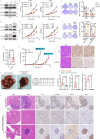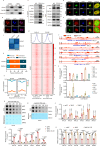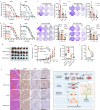CRISPR screening reveals that RNA helicase DDX41 triggers ribosome biogenesis and cancer progression through R-loop-mediated RPL/RPS transcription
- PMID: 40790042
- PMCID: PMC12340132
- DOI: 10.1038/s41467-025-62743-5
CRISPR screening reveals that RNA helicase DDX41 triggers ribosome biogenesis and cancer progression through R-loop-mediated RPL/RPS transcription
Abstract
The RNA helicase DDX41 is a DEAD-box helicase that is well known as a virus sensor in dendritic cells and a tumor suppressor that is frequently mutated in myeloid neoplasms. However, the functions and relevance of DDX41 in solid tumors remain largely unexplored. In this study, through in vivo CRISPR screening, we demonstrate that DDX41 is highly expressed in various solid tumor types and promotes tumorigenicity in liver cancer. Mechanistically, DDX41 facilitates R-loop processing and accelerates the transcription of RPL/RPS genes, thereby promoting ribosome biogenesis and protein synthesis. Additionally, we show that the acetyltransferase KAT8 is required for H3K9ac modification of the DDX41 promoter and that NR2C1/NR2C2 are responsible for DDX41 expression. Moreover, elevated DDX41 levels increase liver cancer cell sensitivity to protein synthesis inhibitors; treatment with homoharringtonine (HHT), an approved drug, significantly inhibits tumor growth in DDX41-overexpressing liver cancer models. Taken together, the results of this study highlight that DDX41 acts as an oncogene in liver cancer and suggest that protein synthesis inhibition may be a promising therapy for liver cancers with high DDX41 expression.
© 2025. The Author(s).
Conflict of interest statement
Competing interests: The authors declare no competing interests.
Figures







References
-
- Lu, H., Yang, M. & Zhou, Q. Reprogramming transcription after DNA damage: recognition, response, repair, and restart. Trends cell Biol.33, 682–694 (2023). - PubMed
-
- Tettey, T. T., Rinaldi, L. & Hager, G. L. Long-range gene regulation in hormone-dependent cancer. Nat. Rev. Cancer23, 657–672 (2023). - PubMed
-
- Lourenco, C. et al. MYC protein interactors in gene transcription and cancer. Nat. Rev. Cancer21, 579–591 (2021). - PubMed
MeSH terms
Substances
Grants and funding
- 82121004/National Natural Science Foundation of China (National Science Foundation of China)
- 82472626/National Natural Science Foundation of China (National Science Foundation of China)
- 82472641/National Natural Science Foundation of China (National Science Foundation of China)
- 82172937/National Natural Science Foundation of China (National Science Foundation of China)
LinkOut - more resources
Full Text Sources
Medical

